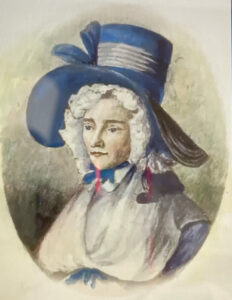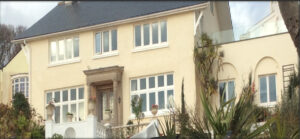In celebration of Women’s History Month in March 2024, Jo Talbot Bowen gave a fascinating talk to the Devon History Society on the artist and diarist Elizabeth Simcoe (1762-1850).
E. Simcoe portrait, Library and Archives Canada / Acc. No. 1972-118-2 / e011213498
Simcoe grew up in Honiton, and returned to Devon after spending several years in Canada during her husband’s term as the first Lieutenant Governor of Upper Canada. Jo has a very special connection to Elizabeth Simcoe, as she purchased Simcoe’s former summer residence in Budleigh Salterton (now Simcoe House) in 2017.
Simcoe House (The 19th century summer villa of the Simcoe family) from the south. Photo by Jo Talbot Bowen
After providing us with an account of Simcoe’s biography and travels, Jo explored Simcoe’s vast list of creative interests and endeavours, which was truly remarkable. Simcoe was a skilled landscape artist and illustrator, and some of her surviving letters and diaries feature charming drawings of natural creatures. Jo then surveyed Simcoe’s endeavours beyond the canvas and the page, focusing on Simcoe and her daughters” contributions to architectural design and interior decoration in numerous churches in Devon. These include St Mary’s Church, Hemyock, Holy Trinity Church at Dunkeswell Abbey and St Nicholas Church, Dunkeswell. Such work enabled Simcoe both to develop her craftwork and channel her evangelical piety, and evidence of her influence can be found in mosaics, stained glass, and stone and wood carvings. Jo also highlighted the difficulties of definitive attribution, particularly as humility and community lay at the heart of the Simcoe women’s spirituality.
The wealth of research undertaken by scholars of women’s history over recent decades has brought the stories of countless women to light, revealing their contributions to and participation in key historical events, movements and debates. Jo’s talk encouraged us to revisit Elizabeth Simcoe’s truly impressive – yet still somewhat overlooked – artistic achievements, and to situate her alongside other pioneering women patrons, architects and designers of nineteenth-century Britain. While so many of women’s historical experiences lie beyond our grasp, Simcoe’s creative legacy remains palpably accessible to us in the fabric of Devon’s churches.
Rhian Jones – DHS Volunteer


